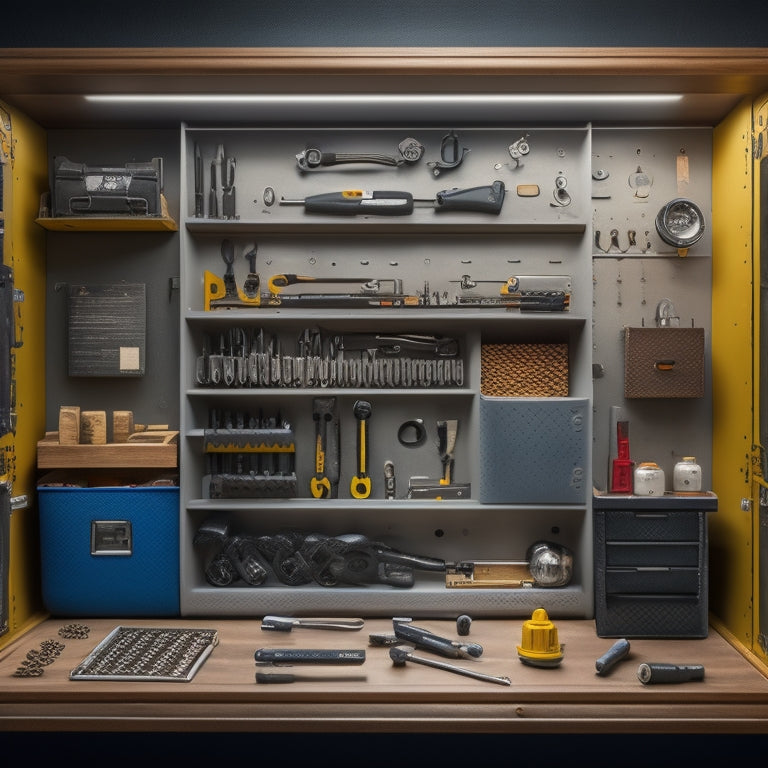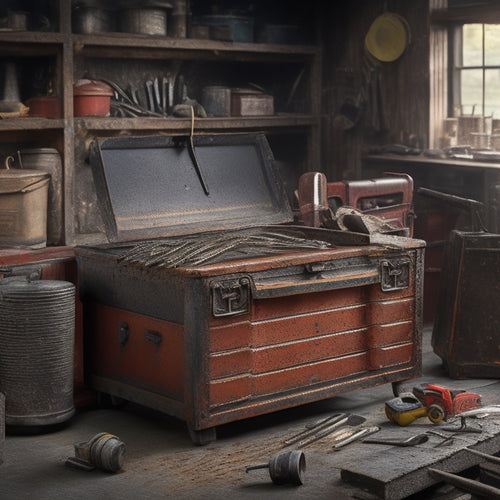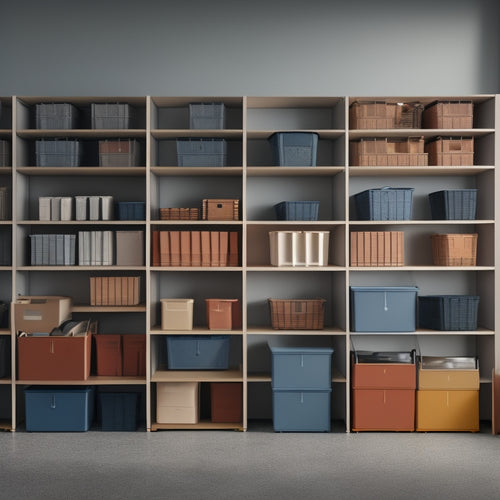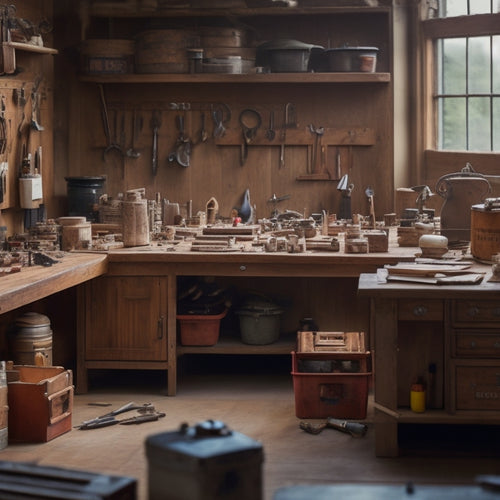
The Best Way to Organize Your Tool Box in 5 Steps
Share
To organize your tool box in 5 steps, start by purging unwanted tools and items, discarding broken or hazardous tools and donating gently used ones. Next, categorize your tools by functionality, grouping hand tools together and separating power tools into distinct categories. Assign a home for each tool, storing heavy tools in easy-to-reach areas and frequently used tools in convenient locations. Employ storage containers effectively, choosing solutions customized to specific tools and labeling each container. Finally, maintain your organized tool box by cleaning and inspecting tools regularly, returning them to their designated spots, and monitoring the toolbox's condition.
Key Takeaways
- Purge unwanted tools and items, discarding broken or hazardous ones and donating gently used tools to local charities or community organizations.
- Categorize tools by functionality, grouping similar tools together and highlighting multi-functional tools for easy access and efficiency.
- Assign a home for each tool, storing frequently used tools in convenient locations and less frequently used tools in designated areas.
- Utilize storage containers effectively, choosing solutions tailored to specific tool needs and labeling each container for easy identification.
- Maintain your organized toolbox by regularly cleaning tools, scheduling routine inspections, and keeping a record of tool maintenance and repairs.
Purge Unwanted Tools and Items
Tackling tool box clutter begins with a ruthless purge of unwanted tools and items. You'll be surprised at how much junk you've accumulated over the years. Be honest with yourself – if you haven't used it in the past year, you probably won't miss it.
Set aside broken or damaged tools, duplicates, and items that are no longer relevant to your projects. Consider donating gently used tools to a local charity or community organization. Not only will this declutter your tool box, but it'll also support a good cause through tool donation.
As you sort through your tools, keep safety considerations in mind. Discard any tools with broken handles, rusty edges, or worn-out electrical components. These can be hazardous to your health and may cause accidents.
Be cautious when handling sharp objects and electrical tools, and make sure to wear protective gear like gloves and safety glasses. Remember, a cluttered tool box can lead to accidents and mistakes.
Categorize Tools by Functionality
With your tool box purge complete, it's time to categorize your remaining tools by functionality. This step guarantees you can quickly find the right tool for the job, reducing frustration and increasing productivity.
Start by grouping hand tool types, such as pliers, wrenches, and screwdrivers, together. Next, categorize power tool categories, like drills, saws, and sanders.
Don't forget to separate specialized tools, like tile cutters or drywall anchors, which serve a specific purpose. Identify multi-functional tools that can be used for multiple tasks, like a cordless drill that can also be used as a driver.
Consider tool usage frequency, placing your most frequently used tools in easy-to-reach locations. Finally, set aside maintenance tools, like lubricants and cleaning supplies, which are essential for tool upkeep.
Assign a Home for Each Tool
Now that your tools are categorized by functionality, it's vital to assign a home for each tool within your tool box or workshop. This guarantees that you can quickly find the tool you need, reducing downtime and increasing productivity.
It's also fundamental for safety, as a cluttered workspace can lead to accidents.
To assign a home for each tool, consider the tool types and storage solutions that make the most sense for your workshop.
For example:
-
Heavy tools, like hammers and wrenches, should be stored in easy-to-reach locations, like the top tray of your tool box or on a pegboard.
-
Frequently used tools, like screwdrivers and pliers, should be stored in a convenient location, like a nearby drawer or on a countertop.
-
Less frequently used tools, like specialized equipment, can be stored in harder-to-reach locations, like on high shelves or in separate storage containers.
Utilize Storage Containers Effectively
Your tool box or workshop is filled with an array of tools, each with its own unique characteristics and storage needs.
To maximize storage space and keep your tools organized, you'll need to employ storage containers effectively. Start by selecting storage solutions that fit the specific needs of your tools. For example, small parts like nuts and bolts can be stored in small plastic bins, while larger tools like hammers and saws can be stored in larger containers or on pegboards.
Label each container so you can easily identify what's inside, and consider using clear or transparent containers to improve tool visibility. This will save you time and frustration when searching for a specific tool.
Maintain Your Organized Toolbox
You've implemented a well-organized tool box using effective storage containers, but the job's not done yet.
Maintaining your organized toolbox is essential to guarantee it remains functional and safe.
Regularly clean your tools and storage containers to prevent rust and corrosion. This will also help you identify any damaged or worn-out tools that need replacement.
Here are three tool maintenance tips to keep in mind:
- Schedule routine tool inspections: Set a specific date each month to inspect your tools for damage or wear.
- Label and date tool maintenance records: Keep track of tool maintenance, repairs, and replacements to guarantee you're staying on top of your toolbox's condition.
- Store tools in their designated place: Make it a habit to return tools to their assigned storage container after each use, preventing clutter and misplacement.
Frequently Asked Questions
How Do I Deal With Tools That Don't Fit in Their Assigned Space?
When tools don't fit, you'll need to reassess your tool storage strategy. Consider vertical space optimization by using stackable containers or hooks, and repurpose unused areas to create a functional, safe, and efficient storage solution that works for you.
Can I Organize My Tool Box if I Have Limited Mobility or Dexterity?
As you steer through your tool box, don't let limited mobility or dexterity hold you back! You can still organize with ease using adaptive tools and mobility aids, like ergonomic grips and adjustable handles, that cater to your needs and guarantee a safe, efficient workflow.
What if I Have a Lot of Duplicate Tools With Different Purposes?
You're facing a common issue: duplicate tools with different purposes. To tackle this, try tool categorization by grouping similar tools together, then differentiate their purposes by labeling or color-coding, ensuring you grab the right one for the job, every time.
How Often Should I Clean My Tool Box to Prevent Rust and Corrosion?
Your tool box is a goldmine, but neglect it and it'll turn into a rusty graveyard! Clean it regularly, ideally every 1-2 months, to prevent rust and corrosion - apply corrosion inhibitors and dry tools thoroughly to keep your tools shining like new.
Are There Any Specific Tool Box Organization Systems for Specific Trades?
You'll find trade-specific solutions, like electrician's tool chests with built-in wire spool holders or mechanic's tool boxes with customizable compartments, offering innovative tool storage innovations that cater to your unique needs and prioritize safety on the job.
Conclusion
You've finally achieved the organized toolbox of your dreams! Now, imagine being able to find that one specific screwdriver in seconds, without having to dig through a jumbled mess. Can you visualize the feeling of satisfaction and control that comes with knowing exactly where everything is? By following these 5 simple steps, you've earned the right to bask in that feeling every time you open your toolbox. What's the first project you'll tackle with your newfound efficiency?
Related Posts
-

Maximum Capacity Tool Boxes for Heavy-Duty Use
You need a maximum capacity tool box that can withstand the rigors of heavy-duty use, protecting your essential tools...
-

Choosing the Right Stacked Storage Bins
When choosing the right stacked storage bins, you'll want to evaluate your storage needs, considering inventory types...
-

Top 7 Parts Tray Organizers for Productivity
You can optimize your workspace and enhance productivity with the right parts tray organizer, which can help you cate...


